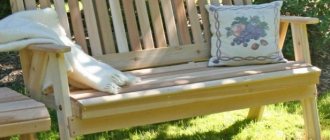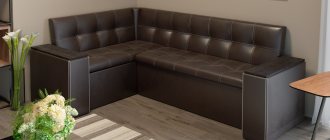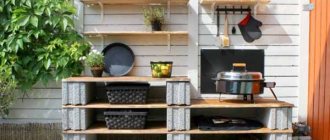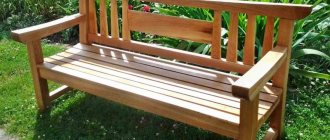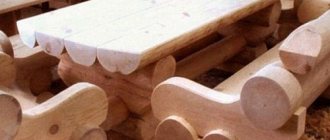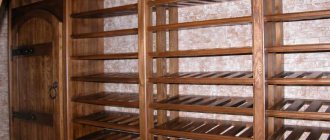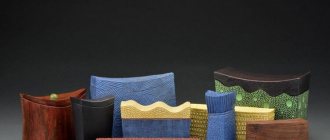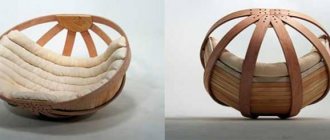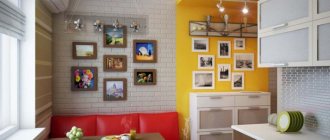Photos of original benches (options for cottages and gardens)
Everyone can imagine what the most ordinary bench looks like, but not everyone likes simplicity and most opt for original solutions. Everyone wants to have something that, for example, a neighbor in the country does not have. Almost all summer residents start by decorating their summer cottage or garden plot, and there are also many options here. Alternatively, you can start designing the area by installing a bench, having previously decided on a resting place. After all, a place of rest is not needed later, it is needed now. Therefore, the design of this place should be tackled at the first stages of the process of decorating a summer cottage or personal plot, and only then proceed to the design of the rest of the territory.
As a rule, summer residents are very keen on growing various green spaces and flowers. Especially, there are a lot of them near buildings. Alternatively, you can combine plantings with a recreation area by installing a bench not far from the dacha. In this case, everything will look organic: green spaces, flower beds, and an original bench.
Two flower beds made of boards and a bench between them
There are a huge number of options: from the simplest to the most sophisticated. The simplest option may consist of two wooden boxes in which flowers are planted, and two boards built between these boxes. The boards must be planed and well sanded. This structure can be placed directly next to the wall of the dacha. You can attach a couple of the same planed boards to the wall, which will serve as a kind of backrest. Instead of wooden boxes, you can install concrete cabinets, which can last much longer than wooden elements.
Garden bench-flower bed
It is very simple to build such a structure, and most importantly quickly. As for the boards, you can buy them ready-made or make them to size yourself using untreated boards. But in this case, you will have to work hard, but the bench will not cost anything, and the result will definitely please you. If concrete flowerpots are used, the boards can be secured using metal corners. The only problem is the difficulty of drilling holes in concrete. Under no circumstances should you use a hammer drill, as a flowerpot, even a concrete one, will easily split, especially if it is made independently.
Flowerpots as legs
You can not fasten the boards, but instead of the boards put a huge log, which does not need to be fastened if it is installed correctly.
As mentioned above, there are many options, and they are created on the basis of the real possibilities that the owner of the dacha has. Alternatively, you can simply install a bench for relaxation away from flowers and green spaces. After all, it’s no secret that various insects hide in flowers and between the leaves of plants, which in no way encourage rest, but, on the contrary, force you to leave behind the worst memories of your holiday.
A bench made of boards is an interesting option
As a bench, you can use hollow blocks, into the voids of which treated boards are simply inserted, which can serve as seats.
Bench made of hollow blocks and timber
To make sitting comfortable, the sharp corners of the blocks should be rounded. It's good if these blocks turn out to be heavy and large. If the blocks are small, then they can be pinned together into one piece.
How to make a garden bench with your own hands
Selection of tools and materials
The most important thing is to choose what the bench will be made of. The most popular option is logs or wooden planks. But plywood or laminated pressed boards are also suitable.
Depending on the type of bench material, tools for manufacturing are required. The main requirement for safety and ease of work is the serviceability of devices and the ability to handle them.
What you will need:
- hacksaw or circular saw;
- plane;
- sanding machine or sandpaper of varying degrees of grain;
- screwdriver and drills;
- roulette;
- level, ruler, pencil.
Experienced craftsmen can replace the screwdriver with a hammer and nails.
Different materials are used to make the bench. The choice is primarily related to the availability of raw materials and ease of processing.
You will also need stain, varnish or paint, primer for paint, brushes and rollers.
Log bench
The site can be decorated in any style, but almost everyone moves away from standard approaches to solving the problem. Everyone wants to have something of their own. But not everyone knows that what is new is an improvement on the old. As an option for a new, but somewhat improved old one, this is the option of using a log as a bench. As a seat, you can use a log of large diameter, sawn lengthwise. A log of smaller diameter, also sawn lengthwise, is used as a backrest. Or a trunk with a smaller diameter, but cut closer to the edge. Narrow sections of logs are used as legs.
Log bench - quick and easy
The legs and seats are connected to each other using metal pins. Holes of slightly smaller diameter are drilled for the pins. The pins must fit into the holes with force. In this case, half of the pin is driven in by hitting the pin, and the other half is driven in by hitting the wood. As a rule, they do not hit the wood itself, since marks from the hammer may remain, but with the help of a wooden point. Such a connection must be reliable, although there are many mounting options.
Bench option without backrest
In the photo just above, you can see another option, in the “ethnic” style. Its organization is associated with the presence of stone, although this option is quite feasible if there is a log. A fairly thick log is used as a seat, and a part of a large diameter log is used as legs. In one and the other part of the deck, grooves are cut for the seat. An ax or grinder is used as a tool. Alternatively, you can use a chainsaw. These are not post-Soviet “Friendships” or “Urals”, which have significant weight, and are, perhaps, convenient for felling pine trees in Siberia. If you take the Calm chainsaw into service, then with its help you can make even lesser works of art.
It is possible to make a table from logs, which is simply necessary in the country. In the photo you can see the results of such actions. The tabletop is made of boards, and the rest of the ensemble is made of logs of different diameters.
Table with log benches
The next bench, built in this style, has a completely original design. Here, the legs and armrests are made of branches of various thicknesses, and the seat is made of processed, high-quality unedged boards.
Option for a wooden bench for the garden or dacha
Another bench is made in the same style. The only difference is that the boards and branches have the opposite direction. The result is a completely different look. As for execution, no special skill is required. The more careless the end result, the more valuable it is. In any case, this is how others perceive this approach. Most likely, people are tired of imaginary perfection and they prefer handicraft and primitivism.
Wicker back - not often seen
Alternatively, you can organize a rest area around the tree and install a bench.
Relaxation area under a tree
This is not at all difficult if you install a swing and a gazebo nearby. It is better to build a pergola, similar to an arch, above the bench itself. All that is missing for a complete relaxation is a pond, fountain or waterfall.
Canopy ideas
If you can’t do without shade and protection from rain on your lawn or garden, you can make a canopy for a bench.
- The awning is a modern classic; its fabric, made of durable material, not only protects from the sun, but also from rain, even snow! It can be a continuation of the traditional roof, which immediately becomes much more than just a stylish way to create shade.
- Who said you can't use tents throughout the summer? By placing a tall tent over the bench, you can create a dome that will completely protect everything that is under it.
- Consider also the true classics. Awnings became popular from the mid-eighteenth century. They protect us not only from excessive sun, but also from rain.
- A canopy made from climbing plants is a reinterpretation of traditional structures. Well-defined structure, beautiful design and undeniable excellence - all this will give a stylish look to any garden. The good old pergola, the image of which has been completely changed, will appeal to all nature lovers. The wooden structure not only provides shade, it brings us back to nature.
- You can protect yourself from excessive sun exposure with a simple homemade umbrella. This is one of the most flexible methods. Umbrellas can be round, angular, large, small, the choice is huge.
- Those who love permanent structures and Mediterranean style can create a gazebo and seating area in the garden.
- An arch is a circular structure with a roof, the perfect way to create a space for a barbecue or a nice lunch with cool tea.
- A delicate bamboo rug with cast iron brackets, combined with rustic-style furniture, will decorate any relaxation area.
Benches made of metal and wood
As a rule, no one decided to build a bench out of metal. In the summer, they can heat up to such temperatures that it makes no sense to talk about rest at all. In case of cold weather, the picture is the same. The bench becomes so cold that it is impossible to sit on it. But benches using a combination of metal and wood are the most in demand. As a rule, the frame is made of metal, which ensures high reliability of the structure, and the seat and back are made of wood, which provides a certain comfort.
Bench made of profile pipe
If the design is improved and soft armrests, soft seats and backs are made, as in the photo, then such a design can compete with the most modern options for rest benches. To make the seats, armrests and backrests soft, it is enough to cover furniture foam rubber with a suitable material. In this style it is possible to build a tabletop.
On a note! When using wood, it is advisable to leave gaps of up to 5 mm between individual elements. This is due to the fact that when the ambient humidity changes, the dimensions of the elements also change.
Stylish benches made of metal and wood
In the process of creating a seating area, care should be taken to ensure that there are no sharp corners, especially in metal structures. This is very important if you have children. All elements of the ensemble, such as benches, tables, garden chairs, are made from round and square pipes, bending them so as to create smooth transitions.
Table and bench made of pipes and boards
The presence of metal allows you to bend structures of any shape, although this cannot be done so easily and you need a special device. The presence of such capabilities allows you to bend structures in one go, without using other tools, such as a grinder and a welding machine. The main thing is to think through the design down to the smallest detail. If wood is used, then only well-processed wood. Wooden elements should not be allowed to have burrs or chips.
DIY making
To make a bench from metal with your own hands, you do not need to have practical skills in construction or furniture assembly. Adequate knowledge of using hand and power tools. There are several ways to manufacture metal structures.
Material and tools
Before starting production, you need to prepare:
- metal corners, profile pipes, forged elements;
- welding machine;
- grinder with metal discs;
- metal brush;
- brushes, roller, primer, special paint.
If the seat will be covered with wood, you will need boards, a hacksaw or miter saw, a drill, bolts or screws.
Bulgarian (Photo: Instagram / tovarka.ekb)
Preparation and drawing up of drawings
Before assembling the structure, you need to draw up a diagram. It should indicate the dimensions and the appearance of the finished structure from different sides. When calculating sizes, you must take into account:
- minimum backrest height - 30 cm;
- minimum bench width - 30 cm;
- length of the structure - 60 cm must be allocated for one person;
- bench height is about 45 cm.
Forged benches
To make a forged bench, you can buy ready-made parts or make them yourself. If the second option is chosen, there are two types of forging that can be used:
- Cold forging. Involves performing work on manual machines. In order not to spend money on purchasing equipment, you can assemble it yourself.
- Hot forging. It requires a forge and an anvil. The workpieces are heated to maximum temperature and processed with hand tools.
After preparing the parts, you can begin assembly:
- Weld the sidewalls through the longitudinal guides.
- Weld the back frame.
- Weld individual forged parts to the finished structure.
When the rough work is completed, you need to clean the welding seams and coat them with an anti-corrosion compound.
Forged bench (Photo: Instagram / lazarrgo)
Bench made of profiled pipe
This material is easy to work with. You need to prepare the required number of tubes. It is better to choose structures with a square or rectangular cross-section with a wall thickness of 3 mm. Assembly steps:
- Cut the tubes with a grinder.
- Clean the ends from burrs.
- Weld the parts.
- After making the frame, cut the lumber to size for the seat.
- Clean the boards with a sander.
- Secure the boards over the frame with bolts.
All that remains is to cover the wood with two layers of varnish or special paint.
Bench made from corners
The easiest way to make a bench for the garden. Assembly:
- Mark the corners and cut with a grinder.
- Clean the ends with a file.
- Lay out the parts on the table in the form of a finished structure.
- Weld the corners.
- Cut the boards for the seat with a hacksaw or miter saw.
- Sand wooden surfaces.
- Secure the boards to the metal frame with bolts.
Protect the wood from moisture and temperature changes with varnish or special paint.
Bench made from corners (Photo: Instagram / maksimliashchynski)
Scrap metal bench
To make your fantasies come true, you don’t need to buy sheet metal, corners, profiles, pipes. It is enough to go through the contents of the garage, basement, shed and select scrap metal. Any designs can be made from it.
Assembling a bench without a back
This is the simplest design option. You need to assemble a U-shaped metal structure from corners or profiled pipes and cover it with boards in the seat area.
How to make a bench with a back
It is more comfortable to sit on a bench with a backrest. It can be assembled from profile pipes, angles, forged elements:
- Prepare a template according to which the sidewalls will be assembled.
- Assemble the sidewalls from corners or profile pipes. Check the angle on the parts.
- Connect the sidewalls with horizontal guides in the area of the back and seat.
- Secure the boards over the guides.
- Treat joints and paint wooden surfaces.
Bench with back (Photo: Instagram / _kmcby_)
Benches made of boards
The most popular option is benches made of boards. There are quite a lot of execution options. There are even designs that look like sofas. If you put soft pillows on them, you can lie down.
This garden bench is more like a sofa: if it is of sufficient size, you can lie down
Garden furniture designs, based on a modern approach, are assembled simply. As a rule, they consist of rectangles with partitions made of thinner wood, connected together into one whole.
If you stretch your imagination and put it to work, you can build a work of art from an ordinary bench if, for example, you install wooden wheels instead of legs and armrests.
A bench made of boards with a back and wheels instead of sides - looks interesting
One of the simplest designs of a country bench consists of one board, to which legs are attached in the shape of the letter “X”. Our ancestors built similar shops, although they can still be found today.
Traditional bench design
Using wood, you can build a bench in the shape of the letter “P”. In this design, it is very important to ensure reliable fastening of the seat and legs. This option involves the use of a thick board or timber for reliability. As an option, you can install the board “on edge” for greater rigidity, and for greater reliability it is recommended to fasten it using metal corners.
This photo shows an option where the cut is made at 45 degrees. This is not difficult to do with the help of a special tool. If you connect all the parts, you get an angle of 90 degrees. If the board is thick and the seat does not sag, then the bench will last quite a long time.
In the photo below you can see another option for an interesting solution, which is characterized by increased reliability. Boards of different lengths are used as legs. The difference in length is the thickness of the board: every second board should be shorter. The structure is connected using nails. Moreover, through one board, the nails are driven either into the board for the seat or into the board for the legs.
Modern style bench
Requirements that a garden bench must meet
Convenience
The bench should be comfortable.
First of all, you need to think about the ergonomic design of the furniture for relaxation. It should be convenient and comfortable. It is best to make furniture with a backrest on which you can lean back and relax.
Safety
Safe
A garden bench must be strong, carefully assembled and withstand heavy loads. For these purposes, it is best to use high-quality materials and fittings.
Resistance to changes in humidity and temperature
Reliable
Since the furniture is made for the garden or yard, the material must withstand all climatic changes without defects or damage.
Prices for garden benches
Garden benches
Original solutions
Along with the classical approach to the process of making benches, there is also an original one, although solving such a problem requires appropriate materials and tools.
For example, you can also build a bench from a large stone if you attach an appropriate wooden platform to it.
Bench made of stone and boards
If bamboo is available, a seat is also made from it, which will take on a more exotic look.
Made from bamboo, and whole
Or a stone.
Sitting in winter will be unpleasant, but beautiful...
It all depends on the flight of fancy. A real owner does not have unnecessary things or materials in his dacha. With a reasonable approach, you can attach any thing, and it will not just lie around in the country or lie like a dead weight in the garage or shed.
What can you build a bench from?
The variety of materials for modern craftsmen is amazing. The choice in each case depends on the skills and experience of the master himself, and his skills in handling construction tools. The following materials are considered the most optimal for independent work:
- Wooden beam.
- Wooden pallets, which have a very convenient shape.
- Profile metal pipes.
- PVC pipes.
Brick and natural stone are used for the construction of non-mobile structures. It is very beneficial to use combinations of various materials, for example, plaster stone and a metal frame, support posts made of concrete and wooden seats, backrests, and armrests.
How to make a bench: photo reports
Naturally, not every owner has a set of tools for making benches from stone, but everyone has a minimum set of tools for working with wood, especially since these are very simple and affordable tools. Therefore, it makes sense to consider wood structures. Everything that is done with one's own hands is ultimately a source of pride.
Bench without back
The design, although simple, has a rather impressive appearance due to the material used. The legs are made from timber with rounded edges. As a last resort, such a beam can be prepared independently from round logs of small diameter, trimming them on 4 sides. The result will be the same timber. Therefore, there should be no problems with the construction of the bench. The legs of the bench will be made from this material. To do this, you should lay the cut beams flat (horizontally) one on top of the other. It is this design solution that brings a certain exclusivity to the design.
A simple bench looks interesting due to the material
The bench without backrest is 120 cm long, 45 cm wide and 38 cm high. It is permissible to round the edges of the beam in any way. In order not to strain too much, you can already find a ready-made, profiled beam. Although it will cost much more, it is a pleasure to work with it.
Depending on the size of the bench, it is not difficult to calculate how much timber is required. If you take a beam with a cross-section of 70x70 mm, then with a height of legs of 380 mm, it is enough to place 5 beams on top of each other. We calculate: 45 cm multiplied by 5 pieces. and you get 2.25 m of timber. Since there are 2 legs, there will be 2 times more timber, which means 4.5 meters of timber. A board 40 mm thick and 90 mm wide is used as a seat. Given the width of the bench, you will need 5 boards, 1.5 meters long. If you calculate more accurately, you will need 1.2 m x 5 pcs. = 6 m of board.
At the first stage, boards are cut according to size. In this case, it is necessary to round off all sharp edges. To do this, you can take a plane or just coarse sandpaper and carefully process the boards. In order not to have to do much yourself, there is another option: you can simply negotiate at the sawmill and get a well-processed board, especially since they have all the capabilities for this. All that remains is to take them and coat them with varnish.
Treated boards
After this, they begin to manufacture the legs, for which the beams are cut into identical sections, 45 cm long, after which they are stacked one on top of the other in 5 pieces. The next stage is connecting the legs for stability. In this case, the beams can be fastened with metal pins or wooden dowels. The distance between the fasteners is 7-10 cm. As a rule, such a connection is made using glue, then the connection is more reliable.
Lines where the pins will be installed
The pin connection requires precise drilling of the holes, otherwise the beams will not be on the same line. For this, it is better to use a template. In addition, the dimensions of the leg elements must be the same, then it will be possible to accurately mark the location for drilling holes. For those who are familiar with drawing, tape measure and pencil, it will not be difficult to do everything correctly.
We make holes in the bars in a checkerboard pattern
The pins should be installed in a staggered pattern, so it is necessary to mark with this feature in mind. In the same way, the boards are attached to the legs at the rate of two holes per board.
If you look from a technological point of view, this is not a bad connection option, but it requires some skill and experience in working with wood. The connection stage can be simplified if the bars for the legs are stacked one on top of the other and firmly connected them using a clamp. Then drilling accuracy will be ensured. Alternatively, the beams can be connected using long metal pins and nuts with washers. In this case, it is enough to drill 2-3 holes through.
The seats can be nailed to the legs, which greatly simplifies the entire manufacturing technology of such a bench.
The bench is made by hand. Finishing work remains
When using nails, it is advisable to hide the heads, as they will then rust, which is completely undesirable. To do this, hammer the nails so that the heads are hidden almost 5 mm deep into the wood; for this, you can use a guide. After this, putty is taken, a little sawdust is added to it to match the color, and the recesses are puttied. After complete drying, the areas are carefully sanded with sandpaper. So that the place where the nails are driven does not stand out against the general background, they are coated with a suitable varnish.
The technology for varnishing wooden surfaces is quite simple, especially since it is described in detail in the instructions for use.
Scheme and drawing
DIY drawings of a garden bench with a back will differ depending on the materials used. All assembly schemes are quite simple, and even a novice master can handle this work.
Experts advise following the standards:
- seat height – 40-50 cm;
- seat width – 50-55 cm;
- back height – 35-50 cm.
However, the parameters can be changed to suit individual needs. For beginners in carpentry, it is better to choose simple forms of products.
The design itself has a very simple structure, so anyone can handle the technology of its creation.
Bench for a summer house made from broken chairs
If you have two old chairs and don’t have enough imagination to adapt them somewhere, then you can make a bench out of them. Only the same ones and strong enough will do. If they are loose, they will have to be repaired. The chairs are disassembled so that the backs and legs remain. After this, two chairs, or rather what is left of them, are installed side by side and their backs are connected using slats of the appropriate thickness.
Bench made from old chairs
To make the structure rigid, at a height of 20 cm from the floor, the structure is tied with the same slats along the entire perimeter. Subsequently, these slats will serve as a footrest, and if the bottom is sewn up, for example, with plywood, then you can store some things here.
We paint the completed structure
After the structure has been strengthened and sanded, it can be painted. In this case, ordinary paint is suitable, which can hide some flaws in the entire structure and especially in old chairs. All that remains is to cut out a sheet of plywood, lay foam rubber on it and cover it with some fabric. At the same time, one should take into account the fact that the bench will mainly stand outside until the coldest weather. Therefore, it is better to opt for, for example, leatherette. In any case, the material must be moisture resistant.
Finished bench made from strusses
Patio bench with canopy
Building your own patio bench is an option that can be easily customized to suit any individual design. This DIY canopy bench is designed to fit a standard mattress. This design includes classic touches.
Materials:
- stain,
- stainless steel screws,
- screws,
- necessary wooden elements.
Step 1. Making the frame
First, a seat support is made from 4 beams, which will be located at a height of 45 cm from the ground. Stainless steel screws are used to connect the parts.
Step 2. Attaching the seat support
First, the front posts are installed, which are attached to the seat frame. Then the rear pillars are installed. If necessary, check the height with a level.
Step 3: Seat Support
Backrests and armrests are installed around the perimeter, which make the structure rigid. These parts support the cushions.
Step 4. Attaching the seat slats
The seat slats are recessed a few centimeters. The planks are secured with several stainless steel screws, they are placed every 15 cm.
Step 5. Securing the jumpers
Recesses are cut out in the jumpers and the parts are fastened groove to groove using glue, screws and clamps.
Step 6: Varnishing
Using a translucent varnish, apply thin layers with a brush and let the bench dry.
Garden bench chair made from pallets
For a reasonable owner, any material has its own value. Garden furniture can be made from cargo pallets without any problems. Moreover, there is no particular need to disassemble them: the back is made from one pallet, and the seat from the other. All that remains is to think about what to make the armrests and legs from.
This is what should happen
One of the pallets is reinforced with additional bars, which are secured with self-tapping screws.
Strengthening the corners of the pallet
After this, a beam with dimensions of 100x100 mm and an arbitrary length is taken, after which 4 identical sections are cut, up to 80 cm long. They are attached in those places where the reinforcement bars, placed in advance, are located. As a result, legs 20-25 cm long will be sufficient. Self-tapping screws with a length of at least 150 mm are used for fastening. During the work, you need to make sure that the bars are screwed correctly so that you can install legs of the same length.
Screwing the legs-supports for the armrests
If after these steps it is not possible to obtain a completely flat structure, then the legs can be filed at the end if the bench does not sit level.
The legs are screwed
The second pallet is attached to the rear pillars, and on both sides there are boards for the armrests.
Almost done
Further - as necessary. If you want to have upholstered furniture, then just buy foam rubber, cut out the required piece and cover it with moisture-resistant material. You can do the same with the back.
If there are no such plans, then you can simply carefully process the wooden elements with sandpaper, after which the bench is simply painted with any paint, any color.
Finished product: pallet chair
Design options
Despite the fact that almost all models of transformers use the same scheme, almost all home-made workers try to design a folding bench in their own way, to make its design more individual and attractive.
